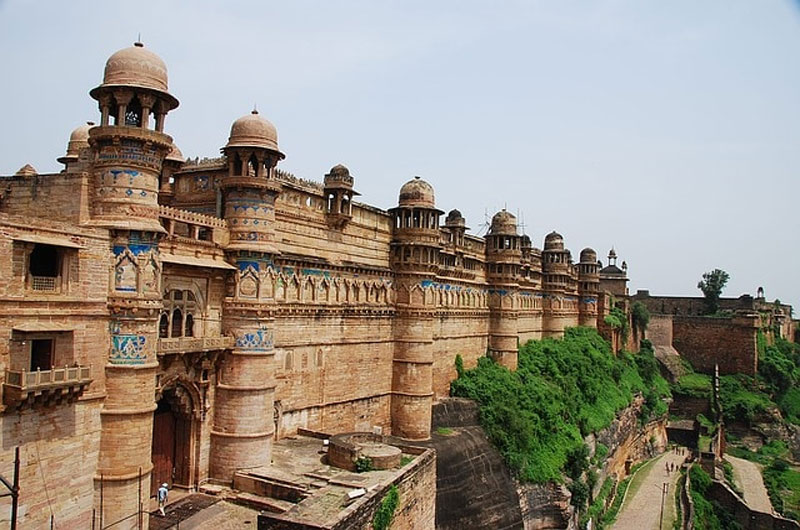
Hill Forts of Rajasthan: Guardians of Rajasthan’s Legacy – A World Heritage Site
The Hill Forts of Rajasthan, comprising six majestic forts spread across the Aravalli Range, exemplify the architectural and cultural heritage of Rajasthan, India. These forts—Chittorgarh, Kumbhalgarh, Ranthambore, Gagron, Amber (Jaipur), and Jaisalmer—were inscribed as a UNESCO World Heritage Site in 2013. Each fort represents a unique blend of Rajput military architecture, strategic planning, and cultural patronage, reflecting the historical and cultural evolution of Rajasthan from the medieval to the early modern period.
Historical Background
- Rajput Dynasties
- Flourished in Rajasthan from the 8th century onwards, known for their valor, chivalry, and administrative acumen.
- Built fortified structures to protect their kingdoms from invasions and uphold their sovereignty.
- Fort Construction
- Constructed between the 8th and 19th centuries CE, each fort served as a center of power and cultural patronage for different Rajput clans.
- Witnessed historical events, battles, and significant cultural exchanges over centuries.
Architectural Marvel
- Design and Structure
- Built using local materials, including sandstone, marble, and granite, reflecting regional architectural styles.
- Features include massive gates, ramparts, bastions, palaces, temples, and reservoirs.
- Designed with intricate carvings, frescoes, and elaborate water management systems.
- Notable Forts
- Chittorgarh Fort: Largest fort in India, known for its Rajput architecture and historical significance, including the siege by Alauddin Khilji.
- Kumbhalgarh Fort: Second-largest wall after the Great Wall of China, enclosing temples, palaces, and a wildlife sanctuary.
- Amber Fort (Jaipur): Renowned for its artistic Hindu-Muslim architecture, including the Sheesh Mahal (Hall of Mirrors) and Diwan-e-Khas.
Specialty of the Hill Forts of Rajasthan
- Architectural Diversity
- Represents the evolution of Rajput military and palace architecture over centuries.
- Showcases a blend of Hindu, Islamic, and Mughal architectural styles and cultural influences.
- Cultural Significance
- Served as centers of governance, cultural patronage, and religious activities for Rajput rulers and their courts.
- Symbolizes Rajput valor, resilience, and cultural identity in the face of historical challenges.
Tourism Aspects
- Visitor Experience
- Guided tours available to explore each fort and learn about its historical and architectural significance.
- Light and sound shows narrating the history and legends associated with the forts, enhancing visitor experience.
- Cultural programs and events showcasing Rajasthani music, dance, and folk traditions.
- Nearby Attractions
- City Palaces: Adjacent palaces and museums in Jaipur, Udaipur, and Jodhpur displaying royal artifacts and art collections.
- Ranthambore National Park: Nearby wildlife sanctuary offering tiger safaris and eco-tourism experiences.
- Pushkar: Famous for its Brahma Temple and annual camel fair, providing insights into Rajasthan’s cultural diversity.
- Events and Festivals
- Pushkar Camel Fair: Annual event attracting traders, tourists, and pilgrims for camel trading, cultural performances, and religious rituals.
- Desert Festival (Jaisalmer): Celebrates Rajasthan’s folk traditions, including camel races, folk music, and dance performances.
Impact on Locality
- Economic Significance
- Boosts tourism and local economy through visitor spending, hospitality services, and cultural events.
- Supports local artisans and craftsmen specializing in traditional crafts, including textiles, pottery, and jewelry.
- Cultural Influence
- Enhances regional pride and historical awareness.
- Promotes preservation of traditional arts, crafts, and cultural heritage.
Preservation and Challenges
- Conservation Efforts
- Managed by the Archaeological Survey of India (ASI) and state authorities.
- Ongoing restoration and maintenance to preserve the architectural integrity and historical authenticity of the forts.
- Challenges
- Preservation against natural weathering, urbanization, and tourism pressures.
- Balancing tourism development with conservation needs to ensure sustainable management of cultural heritage.
Conclusion
The Hill Forts of Rajasthan stand as iconic symbols of Rajputana glory, architectural ingenuity, and cultural heritage. As UNESCO World Heritage Sites, they attract visitors and scholars from around the world, offering a glimpse into Rajasthan’s royal past and vibrant cultural traditions. The ongoing efforts to conserve and promote these forts ensure that they continue to inspire awe and admiration for their monumental scale, historical significance, and enduring legacy for generations to come.
